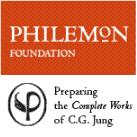

While it is widely believed that the bulk of Jung’s work has been published, this is far from being the case. Unbeknownst to most people, an enormous body of Jung’s work, including an additional 30 volumes and 38,000 letters, remains unpublished to this day.
The newly established Philemon Foundation is dedicated to raising the necessary funds to discover, recover, research, edit, and prepare for publication, The "Complete Works" of C. G. Jung – in distinction from the currently available original 21 volumes of The Collected Works supported by the Bollingen Foundation.
The Philemon Foundation aims to continue and complete the work begun by the Bollingen Foundation, and has been founded with the approval of the Stiftung der Werke von C. G. Jung, the charitable successor to the Association of the Heirs of C. G. Jung.

History of the Collected Works
In 1945, the Project for a Collected Works of C. G. Jung commenced, funded by the Bollingen Foundation. The volumes of the Collected Works were edited by Gerhard Adler, Michael Fordham, and Herbert Read and translated by R. F. C. Hull. William McGuire later became the executive editor. In the United States, the works were published as part of the Bollingen Series, and, in the United Kingdom, by Routledge and Kegan Paul. At Jung’s request, the plan for the German edition of his works, edited by Marianne Niehus-Jung, Lilly Merker Jung, Lena Hurwitz Eisner, Franz Riklin Jr., Elisabeth Rüf, and Leonie Zander, followed that of the English edition. The editorial apparatus of the German edition was taken over from the English edition.
Over several decades, twenty-one volumes of Jung’s writings were published, supplemented by seven volumes of seminars in English, two volumes of letters, the Freud–Jung correspondence, and the Freud–Jung–Jellife correspondence.
Improving Upon the Collected Works
Those responsible for the Collected Works managed to make the bulk of Jung’s published writings available in a comparatively short span of time after his death. This immense task was of great significance. The Collected Works have had an inestimable effect upon disseminating Jung’s remarkable insights worldwide and in enabling the establishment of the professional discipline of Analytical Psychology. In addition, in the preparatory research for this edition, the editors made many important contributions towards understanding the historical development of Jung’s work. With the clarity of hindsight, however, numerous understandable shortcomings have become apparent. None of the editors were trained scholars, and some were not even German speaking. The magnitude of the undertaking was not immediately apparent when they embarked on their mammoth task.
At the beginning of the project, the editors prepared a bibliography of Jung’s known writings. The bibliography was not comprehensive and omitted many of his published and unpublished works. It was not until 1993 that a full inventory of Jung’s unpublished manuscripts in the Jung Archive of the ETH (Eidgenössiche Technische Hochschule – Swiss Federal Institute of Technology) was prepared.
It was Jung’s wish that his works be published in chronological order. The editors, however, selected a thematic approach. In some respects, their decision reflected an important fact in the publication of the Collected Works, namely, that though he was involved in the work, Jung effectively ceded editorial control to the teams in place and had relatively little to do with the eventual form of the Collected Works. This fact seems hardly surprising in the light of Jung’s age and health. He suffered a near fatal heart attack in 1944 and endured a protracted period of convalescence during the stress of the war and its aftermath.
The 70-year-old Jung was still deeply involved in his own creative activity, looking towards the future and relying on his trusted students to secure what was already created. Through the course of his career, Jung frequently revised his work and published different versions of essays in different contexts. The bulk of these variations were not included in the Collected Works. Thus, many historically and theoretically critical formulations which provoked extensive and lively contemporaneous debate and which are critical to an understanding of the scope of Jung’s thinking are simply not found there.
A second unfortunate consequence of this thematic approach to editing is the difficulty of ascertaining when a specific passage was written, thus making it nearly impossible to study the evolution of Jung’s ideas on the sole basis of the Collected Works.
The reproduction of Jung’s writings in the Collected Works was also not without error and the versions reproduced do not always correspond to his manuscripts. The English translation, while stylistically fluent at a literary level, leaves a great deal to be desired, containing interpolations and reformulations that were not of Jung’s hand, as well as misunderstood concepts and general errors.
For more information please click:
The Philemon Foundation
or contact:
Nancy Furlotti, Past Co-President & Director at:
[email protected]
or
The Philemon Foundation
PO Box 1239
Carpinteria, CA 93014-1239



